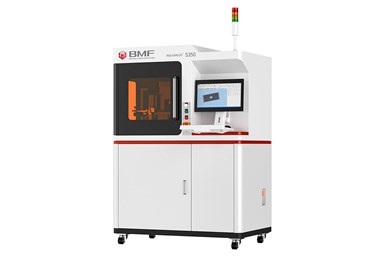BMF’s MicroArch S350 Offers High-Throughput Microscale 3D Printing
The 25-micron resolution printer is said to combine part quality and speed for end-part production.
Boston Micro Fabrication (BMF) has added the microArch S350 to its roster of industrial-grade microprecision 3D printers. The company says this next-generation version of BMF’s 25-micron resolution system offers the highest throughput in the company’s portfolio, combining high part quality with the print speed required for end-part production.
The microArch S350 is built upon BMF’s Projection Micro Stereolithography (PµSL) technology, a technique that enables rapid photopolymerization of layers of liquid polymer using a flash of UV light at microscale resolution. With a larger build volume (100 × 100 × 50 mm) and fewer projection zones to improve print speed, the printer can be used in the production environment or labs to print both microscale parts with high-resolution features or small parts requiring high accuracy or precision.
A new automated lateral membrane shift enables easier part removal or integration with a robotic arm, resulting in increased automation and ease-of-use for end-part production. Additional capabilities include automated resin fill and adjustment, a laser displacement sensor and an advanced roller that spreads layers at greater speed.
The microArch S350 is compatible with a growing portfolio of engineering and ceramic resins suitable for end-use parts, including two new BMF materials: The BMF MED powered by 3D Systems is a rigid amber material for applications requiring biocompatibility, translucency and/or thermal resistance. It provides parts with crisp details that can be sterilized and tested at high temperatures, over 100 °C. The second material is Loctite 3D 3955, which is a high-performance, halogen-free, flame-retardant UL94-V0 high modulus photopolymer resin. It is printable at 60°C.
Since BMF launched its microArch system globally in February 2020, more than 200 customer locations around the world have installed the company’s micro 3D printers for prototyping, research and development, and end-use production. Industries that are driven to miniaturize (such as electronics, optics/photonics, medical devices, microfluidics and life sciences) are able to take advantage of additive manufacturing and innovate in ways that were never before possible, the company says.
“BMF has become the industry leader for printing small and microsized parts requiring high resolution, accuracy and precision in the 2-micron and 10-micron resolution spaces. Now, we’re bringing that experience to an even wider range of end-use applications at the 25-micron level,” says John Kawola, BMF CEO. “While this printer is geared more toward industrial customers that need faster throughput, greater volume and more automation, the result is still best-in-class part quality compared to other DLP platforms and we cannot wait to see what our customers accomplish with it.”
-
Read about BMF’s new research and development center in San Diego, California, where it is developing and incubating end-product ideas that are uniquely enabled by the company’s microprecision 3D printing platform.
-
Check out the features of BMF’s MicroArch S230 which offers design freedom for intricate parts.
-
Watch this episode of The Cool Parts Show to learn how BMF’s micro 3D printing makes tiny detailed parts.
Related Content
-
With Electrochemical Additive Manufacturing (ECAM), Cooling Technology Is Advancing by Degrees
San Diego-based Fabric8Labs is applying electroplating chemistries and DLP-style machines to 3D print cold plates for the semiconductor industry in pure copper. These complex geometries combined with the rise of liquid cooling systems promise significant improvements for thermal management.
-
This Drone Bird with 3D Printed Parts Mimics a Peregrine Falcon: The Cool Parts Show #66
The Drone Bird Company has developed aircraft that mimic birds of prey to scare off problem birds. The drones feature 3D printed fuselages made by Parts on Demand from ALM materials.
-
DMG MORI: Build Plate “Pucks” Cut Postprocessing Time by 80%
For spinal implants and other small 3D printed parts made through laser powder bed fusion, separate clampable units resting within the build plate provide for easy transfer to a CNC lathe.













